Do you have a question about the KYMCO Compagno 50i and is the answer not in the manual?
Explains the safety alert symbol with exclamation point, indicating potential danger to rider.
Indicates special precautions to take to avoid damaging the scooter.
Highlights key information about a procedure or clarifies an operation.
Provides key safety tips for riding, including wearing a helmet and being visible.
Emphasizes performing a safety inspection before each ride for safe operation.
Offers advice for riding in adverse weather conditions like rain, focusing on caution.
Warns against modifying the scooter, as it can lead to unsafe or illegal conditions.
Details essential protective gear including helmets, eye protection, gloves, and clothing.
Stresses the importance of wearing a properly fitting helmet and eye protection.
Advises on using sturdy boots, leather gloves, and appropriate riding suits or jackets.
Warns that not wearing a helmet increases injury risk and to always wear approved helmets.
Advises consulting dealers for quality accessories and proper installation.
Strongly advises against modifying the scooter, as it can lead to accidents.
Identifies key components like Headlamp, Brake Lever, Fuel Filler Cap, and VIN location.
Identifies more parts including Ignition Switch, Muffler, Center Stand, and Luggage Hooks.
Identifies Left/Right Handlebar Switches and the Instrument panel.
Explains the functions and positions of the ignition switch: OFF, ON, LOCK, and PUSH.
Details how to operate the ignition switch security shutter and the importance of the key code.
Describes the functions of the odometer, speedometer, indicator lights, and clock.
Explains the CELP, Oil Service, and low battery voltage warning indicators.
Details the operation of the electric starter, turn signals, and horn buttons.
Explains the dimmer switch for headlights and the operation of front and rear brake levers.
Guides on checking fuel level, using the fuel tank filler, and recommended gasoline type.
Details how to unlock the seat and use the helmet buckles, with a parking warning.
Lists essential checks before riding: oil, fuel, brakes, tires, throttle, lights, horn, steering.
Warns that neglecting pre-ride checks can lead to serious injury or death.
Provides step-by-step instructions for starting the engine, including safety cautions.
Advises against operating the starter motor for more than five seconds to prevent damage.
Details holding the throttle closed while warming the engine and warming up fully before riding.
Warns that operating with insufficient oil pressure can cause serious engine damage.
Highlights why maintenance is essential for safe, economical, and trouble-free riding.
Explains how to use the maintenance schedule and consult dealers for specific needs.
Stresses dealer inspection after a crash, even for minor damage, to ensure safety.
Warns about hazardous exhaust gases when running the engine indoors during maintenance.
Presents the maintenance schedule and explains the legend for service intervals.
Advises on dealer servicing for safety-critical items and road testing after service.
Recommends premium 4-stroke oil and lists viscosity grades based on temperature.
Details how to check the engine oil level using the dipstick, ensuring it's between marks.
Warns that running with insufficient oil pressure can cause severe engine damage.
Outlines the steps for changing engine oil, including draining and refilling.
Warns that engine and exhaust components can be very hot during oil inspection/replacement.
Specifies oil capacities and procedures for final checks after engine oil replacement.
Details the steps for draining and refilling the transmission fluid, including fluid type.
Advises on servicing the air cleaner filter element, especially in dusty/wet conditions.
Warns that using non-genuine elements can cause premature engine wear.
Details checking throttle grip rotation and measuring free play before each ride.
Explains cleaning carbon deposits, adjusting spark plug gap, and periodic replacement.
Warns that improper spark plugs can cause severe engine damage.
Details checking front and rear brake fluid levels, and what to do if low.
Warns that worn brake pads must be replaced immediately for safe operation.
Explains how to adjust brake lever free-play for responsive brakes and to prevent drag.
Details inspecting brake pad wear indicators in front and rear brakes for replacement needs.
Warns that continually applying the brake lever (dragging) causes quick wear.
Describes the maintenance-free battery and cautions against removing the cap strip.
Advises contacting a dealer if the battery seems weak or is leaking electrolyte.
Frequent fuse failures usually indicate a short circuit or overload in the electrical system.
Warns against using fuses with different ratings, as it can cause system damage or fire.
Warns that failure to follow tire safety instructions may result in an accident due to tire failure.
Details checking tire condition, pressure, avoiding overload, and using correct tires.
Provides recommended tire pressures for rider only and rider with passenger, adjusted cold.
Provides detailed steps for manually adjusting the hour and minute displays on the clock.
Explains the crankcase and exhaust emission control systems and their function.
Covers noise emission control and warns against modifying components affecting noise levels.
Provides overall dimensions, weight, and capacities for engine oil, transmission oil, and fuel.
Details engine type, displacement, bore/stroke, ignition, battery, and lighting specifications.
Lists chassis details and tire sizes for the front and rear of the scooter.
Details warranty coverage, period, and limitations for parts and labor.
Outlines owner's obligations for maintenance and specific exclusions from the warranty.
Explains limitations on implied warranties and KYMCO's liability.
Explains the safety alert symbol with exclamation point, indicating potential danger to rider.
Indicates special precautions to take to avoid damaging the scooter.
Highlights key information about a procedure or clarifies an operation.
Provides key safety tips for riding, including wearing a helmet and being visible.
Emphasizes performing a safety inspection before each ride for safe operation.
Offers advice for riding in adverse weather conditions like rain, focusing on caution.
Warns against modifying the scooter, as it can lead to unsafe or illegal conditions.
Details essential protective gear including helmets, eye protection, gloves, and clothing.
Stresses the importance of wearing a properly fitting helmet and eye protection.
Advises on using sturdy boots, leather gloves, and appropriate riding suits or jackets.
Warns that not wearing a helmet increases injury risk and to always wear approved helmets.
Advises consulting dealers for quality accessories and proper installation.
Strongly advises against modifying the scooter, as it can lead to accidents.
Identifies key components like Headlamp, Brake Lever, Fuel Filler Cap, and VIN location.
Identifies more parts including Ignition Switch, Muffler, Center Stand, and Luggage Hooks.
Identifies Left/Right Handlebar Switches and the Instrument panel.
Explains the functions and positions of the ignition switch: OFF, ON, LOCK, and PUSH.
Details how to operate the ignition switch security shutter and the importance of the key code.
Describes the functions of the odometer, speedometer, indicator lights, and clock.
Explains the CELP, Oil Service, and low battery voltage warning indicators.
Details the operation of the electric starter, turn signals, and horn buttons.
Explains the dimmer switch for headlights and the operation of front and rear brake levers.
Guides on checking fuel level, using the fuel tank filler, and recommended gasoline type.
Details how to unlock the seat and use the helmet buckles, with a parking warning.
Lists essential checks before riding: oil, fuel, brakes, tires, throttle, lights, horn, steering.
Warns that neglecting pre-ride checks can lead to serious injury or death.
Provides step-by-step instructions for starting the engine, including safety cautions.
Advises against operating the starter motor for more than five seconds to prevent damage.
Details holding the throttle closed while warming the engine and warming up fully before riding.
Warns that operating with insufficient oil pressure can cause serious engine damage.
Highlights why maintenance is essential for safe, economical, and trouble-free riding.
Explains how to use the maintenance schedule and consult dealers for specific needs.
Stresses dealer inspection after a crash, even for minor damage, to ensure safety.
Warns about hazardous exhaust gases when running the engine indoors during maintenance.
Presents the maintenance schedule and explains the legend for service intervals.
Advises on dealer servicing for safety-critical items and road testing after service.
Recommends premium 4-stroke oil and lists viscosity grades based on temperature.
Details how to check the engine oil level using the dipstick, ensuring it's between marks.
Warns that running with insufficient oil pressure can cause severe engine damage.
Outlines the steps for changing engine oil, including draining and refilling.
Warns that engine and exhaust components can be very hot during oil inspection/replacement.
Specifies oil capacities and procedures for final checks after engine oil replacement.
Details the steps for draining and refilling the transmission fluid, including fluid type.
Advises on servicing the air cleaner filter element, especially in dusty/wet conditions.
Warns that using non-genuine elements can cause premature engine wear.
Details checking throttle grip rotation and measuring free play before each ride.
Explains cleaning carbon deposits, adjusting spark plug gap, and periodic replacement.
Warns that improper spark plugs can cause severe engine damage.
Details checking front and rear brake fluid levels, and what to do if low.
Warns that worn brake pads must be replaced immediately for safe operation.
Explains how to adjust brake lever free-play for responsive brakes and to prevent drag.
Details inspecting brake pad wear indicators in front and rear brakes for replacement needs.
Warns that continually applying the brake lever (dragging) causes quick wear.
Describes the maintenance-free battery and cautions against removing the cap strip.
Advises contacting a dealer if the battery seems weak or is leaking electrolyte.
Frequent fuse failures usually indicate a short circuit or overload in the electrical system.
Warns against using fuses with different ratings, as it can cause system damage or fire.
Warns that failure to follow tire safety instructions may result in an accident due to tire failure.
Details checking tire condition, pressure, avoiding overload, and using correct tires.
Provides recommended tire pressures for rider only and rider with passenger, adjusted cold.
Provides detailed steps for manually adjusting the hour and minute displays on the clock.
Explains the crankcase and exhaust emission control systems and their function.
Covers noise emission control and warns against modifying components affecting noise levels.
Provides overall dimensions, weight, and capacities for engine oil, transmission oil, and fuel.
Details engine type, displacement, bore/stroke, ignition, battery, and lighting specifications.
Lists chassis details and tire sizes for the front and rear of the scooter.
Details warranty coverage, period, and limitations for parts and labor.
Outlines owner's obligations for maintenance and specific exclusions from the warranty.
Explains limitations on implied warranties and KYMCO's liability.


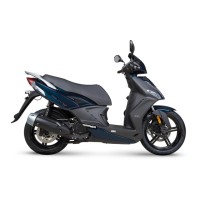
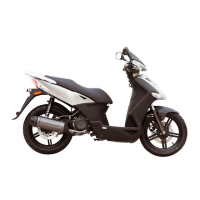
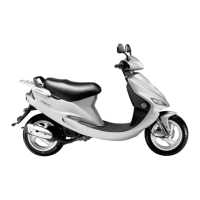
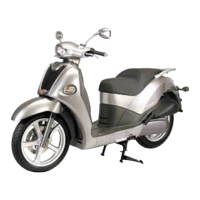
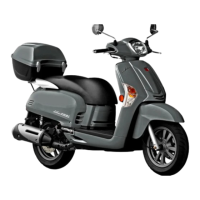

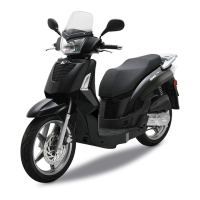
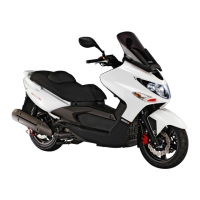


